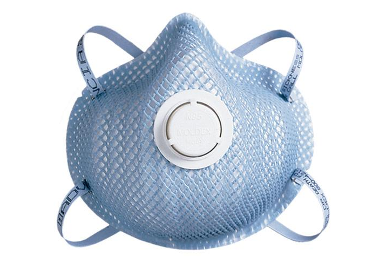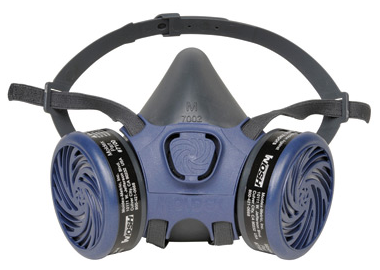Respirators
Respiratory protection devices are not typically required for most laboratory operations as processes generating hazardous aerosols, gases or vapors can be managed with engineering control devices such as fume hoods, glove boxes, snorkel hoods or biosafety cabinets. However, certain operations may not lend themselves to use of engineering controls, such as those conducted as part of field research or animal studies; respiratory protection may be necessary to minimize exposure to volatile hazardous materials, aerosols or potential allergens.
 |
 |
|
N95 - "Dust" mask Masks that are designed to filter 95% of airborne particles, but only when the mask is optimally sealed. N95 masks will not protect users from organic vapors. Single use. May be used voluntarily for control of nuisance dust or particulates. |
Half Face APR (Air Purifying Respirator) Size is fit tested to an individual user to ensure proper function. A variety of cartridges are available to protect the wearer from unique occupational hazards including gasses and vapors. Mask and filters can be reused. Must complete UCSC Respiratory Protection Program requirements. |
When respiratory protection is required, individuals must participate in the UCSC Respiratory Protection program. Key program elements include: training, fit testing in an appropriate respirator, and medical certification. These filtering masks are specifically selected to protect against the particular hazard present.
In some situations, an N95 filtering facepiece (NIOSH approved two-strapped “dust mask”) may be used. Use of N95 masks is typically on a voluntary basis; any process that requires a mask must conform to the UCSC Respiratory Protection program guidelines. Researchers electing to use N95s for protection from nuisance dusts or aerosols should read and review:
Materials should be printed and stored in your IIPP (Injury and Illness Prevention Program) training section; a signature page will document lab workers who have reviewed the material.
If you have questions or would like EH&S to evaluate a hazardous lab process and recommend appropriate controls, please contact 459-2553 or ehs@ucsc.edu to request assistance.
